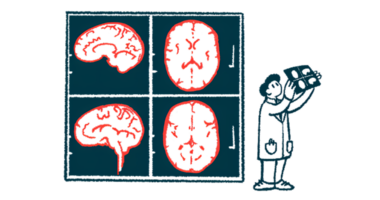Wearable sensors may help monitor, ease Parkinson’s swallowing issues
Up to 80% of patients have dysphagia, showing as lower swallowing frequency

A wearable sensor that’s designed to monitor and improve swallowing led to increased swallowing frequency for people with Parkinson’s disease in a small clinical study.
The scientists believe the sensors are useful for continuous monitoring of swallowing dysfunction, or dysphagia, in Parkinson’s, and may be a way to help ease the symptom.
“This tailored digital health solution not only monitors [Parkinson’s disease] symptoms but also holds potential as an assistive device, marking a significant step in improving the quality of life for [Parkinson’s] patients,” the researchers wrote. The study, “Digital health technology for Parkinson’s disease with comprehensive monitoring and artificial intelligence-enabled haptic biofeedback for bulbar dysfunction,” was published in the Journal of Parkinson’s Disease.
While the most well-recognized symptoms of Parkinson’s are in movement, neurodegeneration can also affect control oover the muscles of the head and neck, called bulbar dysfunction. This drives other disruptive symptoms like dysphagia and breathing difficulties.
Up to 80% of people with Parkinson’s have dysphagia, which often manifests as decreased swallowing frequency. Consequences of dysphagia include malnutrition, difficulties taking medications, choking, and excessive drooling.
Research has focused on wearable sensor technology to provide information about how people with Parkinson’s move in their daily environment. These strategies aren’t designed to assess swallowing, however.
Monitoring bulbar dysfunction
Here, researchers evaluated a comprehensive sensor-based technology capable of monitoring bulbar dysfunction. As part of it, specialized sensors called ADAM sensors are mounted on the hand and throat to continuously monitor swallowing.
When an artificial intelligence (AI)-based algorithm detects that swallowing frequency gets too low, it triggers a motor in the sensor that vibrates to prompt a person to swallow. Called haptic feedback, this should help patients modify their swallowing patterns. The scientists developed the AI algorithm in part using swallowing data from 58 healthy adults without dysphagia.
The sensors are rechargeable and controlled via a mobile device. They can also capture information about standard motor symptoms, sleep, breathing, and heart rate, according to the researchers, who conducted a clinical study (NCT04664634) to test the sensors in 20 people with Parkinson’s, ages 21 and older, who were having mild or moderate dysphagia.
Initial results showed the sensors were sensitive for detecting swallowing, capturing 89% of swallows labeled by experts in standard clinical tests.
The participants were then randomly assigned to receive haptic feedback from the sensors or to monitor swallowing, but not give feedback, for 15 minutes. The groups were then crossed over, with participants initially given haptic feedback now receiving the control monitoring for 15 minutes, and vice versa. All the participants showed an increase in swallowing frequency upon activation of haptic feedback.
Mean swallowing frequency increased by 45%, from an average of 0.77 swallows per minute, below what’s generally seen in healthy people without dysphagia, to 1.1, in the normal range.
“We hypothesize that, in the future, increases in swallow frequency will lead to improvements in swallowing and reductions in drooling,” the researchers wrote.
Patient, caregiver impressions
In a focus group after the study, the participants and caregivers generally had positive impressions of the sensor, but did suggest improvements. The scientists are now working on using the feedback to prioritize a more patient-centric design, including easier application and removal, and skin-tone colors for more discretion. They’re also looking into other functions, such as guided swallowing exercises and remote monitoring with automatic data transfer.
“These improvements aim to maximize user comfort, convenience, and therapeutic benefit while minimizing disruption to daily routines,” wrote the researchers, who also noted a number of possible uses for this type of wearable technology, including in expanding swallowing rehabilitation beyond the clinic, aiding in earlier Parkinson’s diagnoses, and use in clinical trials. Indeed, the ADAM sensor was recently accepted into the U.S. Food and Drug Administration’s Drug Development Tool program to use as a new clinical outcome measure.
While larger studies will be needed to further evaluate it, the scientists indicated the technology, “offers the ability to capture both classic motor and bulbar symptoms in a single integrated solution … representing a significant step toward more comprehensive and patient-centric management of PD.”
The study was supported by the Michael J. Fox Foundation for Parkinson’s Research.







